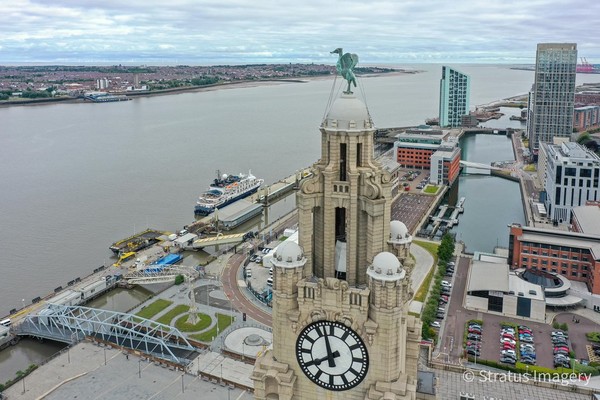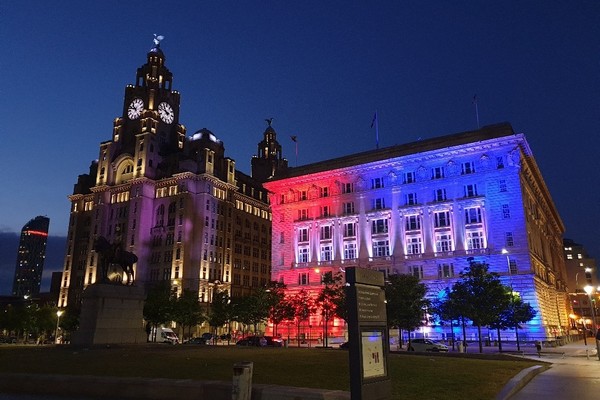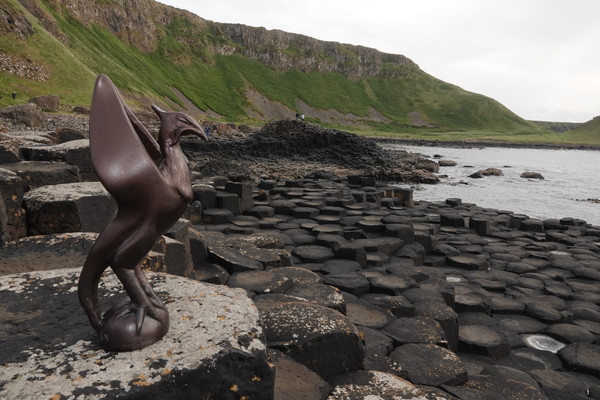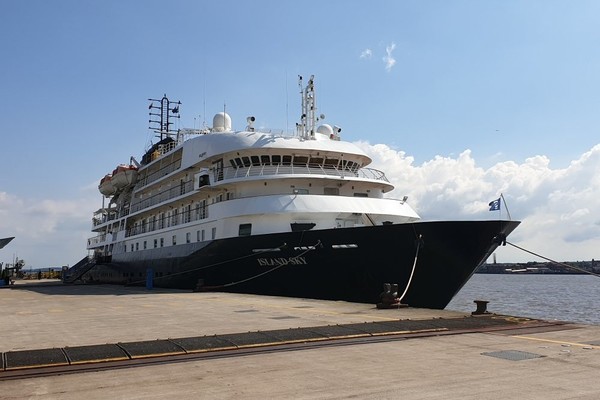It's not the Leaving of Liverpool
By Mike Deegan, Head of Fleet Operations
Well actually it is – at least that’s partly what I wanted to talk about, but I just thought that might be an interesting title of this article. It recalls the old folk song “The Leaving of Liverpool” which is worth a reinvestigation of you’ve not heard it in a while. The Dubliners version from 1965 is perhaps the best-known version. It’s haunting lyric revokes the city’s maritime past and in days when trips for sailors, many of whom came from that city, were measured in years not months or weeks. The words relate the sadness of a sailor bound for California (or “Californ-i-ay” to scan with the melody) via the stormy Cape and who will miss “his own true love” until he returns. As a proud Northerner (I was born in the fair city that is Manchester) Liverpool was a frequent visit for us growing up. It transfixed me with it’s awesome buildings and waterfront where huge liners, smart ferries and busy cargo ships of all shapes and sizes were much in evidence as were the bustling tugs attending them. I was hooked – a career at sea beckoned and I was never diverted from that ambition. Thank you Liverpool – you have provided me with a career that keeps me wanting to keep coming to work to this day (42 years after I stepped aboard my first ship as a fresh faced youth!).

Island Sky berthed at the Prince’s Landing Stage from behind one of the famed Liver Birds (Photo : Stratus Imagery)
Previously I have written in these pages of Portsmouth and it’s historic naval connections which stretch back to King Henry VII. Portsmouth is our home on the south coast of England but in Summer 2021 we had to search for a home in Northern England until Scotland, which had banned cruise ships from landing passengers within it’s borders as a precaution against Covid, re-admitted the cruise industry. We chanced on Liverpool and I was dispatched to inspect the berth and design a Covid-secure boarding arrangement in conjunction with the staff at the city’s Central Cruise Moorings more than ably led by Cruise Operations Manager and proud Scouser John Mawer. John and his team afforded one of the warmest welcomes I have ever encountered from a port (I should not be surprised – Liverpool has just been voted the 2nd friendliest city in the UK behind Belfast by readers of Conde Nast) and their “can-do” and helpful demeanour, aligned with the ease of reaching Liverpool by car, rail or air (or sea come to that!) persuaded us this was a city we had to return to in future. And so we shall in 2023 when we have planned further turnarounds there for our ships – including at the start of two cruises which will circumnavigate Ireland aboard MS Serenissima In August 2023.
I mentioned that Portsmouth can trace it’s history back to King Henry VII. Liverpool can boast of a history stretching back even further, to the 13th Century actually when King John bestowed Borough status on the township by the award of a Royal Charter in 1207. Indeed King John himself is rumoured to have designed the original street-plan, much of which exists to this day in the area behind the historic waterfront. The nearby city of Chester was the principal port in the region but as the River Dee silted up, Liverpool, where the mighty River Mersey meets the sea, began to be established as a port and by the late 18th Century Liverpool was a major seaport and commercial centre. Whilst it is certainly true that Liverpool’s wealth was built on the Sugar and Slave Trades, it is equally true that several prominent Abolitionists (such as William Rathbone, William Roscoe – whose statue is on display in St George’s Hall : see below - and Edward Rushton) were Liverpudlians.
The huge expansion of the city’s docks laid the foundation for the maritime centre that Liverpool is to this day. Renowned Engineer Jesse Hartley (1780 – 1860) designed much of the infrastructure of the docks : not only the docks themselves but also the gigantic warehouses that surrounded them. Today much of his work remains and it has a certain beauty. The buildings around the Albert Dock (perhaps his masterpiece) were restored in the 1980s after years of dereliction (after modern ships grew too large to use his docks designed for sailing ships) and today house the Tate Modern Art Gallery, part of the Merseyside Maritime Museum and countless smart eateries, bars and quirky shops – a must-visit site for visitors to the city and walking distance from our berth.
The Victoria Tower, known locally as the Docker’s Clock, sits on the river frontage by the entrance to the now derelict Salisbury Dock (and is visible from our ship as we sail from Liverpool). It was designed by Jesse Hartley and has six faces, each containing a clock. It is in a poor state of repair today but when working the structure also housed sound signals to assist vessels navigating in fog and a flat for the Dock Master. Owners Peel Holdings have recently announced that they intend to renovate the grade II listed structure in conjunction with the surrounding area.
Behind the Docker’s Clock and inland the Stanley Dock Tobacco Warehouse (Stanley Dock is the only inland dock in Liverpool and is where the Leeds Liverpool Canal meets the Liverpool dock system) is also visible as we depart. Completed in 1901, it is still the largest brick warehouse in the world. It covers 36 acres (is it just me that hates comparisons of area to football pitches? Means nothing to me!) comprises 14 floors and was constructed using 27 million bricks, has 30,000 windows and 8,000 tons of steel. If you look to starboard (right hand side of the ship as you face the front) you can see the Stanley Dock warehouse dominating the skyline about 10 minutes after you leave the berth in Liverpool.
Further north is the Huskisson Dock. It was completed in 1852 and was mainly used for the timber trade initially but later specialised in grain and passenger liners on the North Atlantic trade. It was named after William Huskisson who was a Liverpool MP and Treasurer of the Navy. On 3 May 1941, a direct hit by the Luftwaffe on the ammunition ship SS Malakand which was berthed in the Huskisson Dock, caused an explosion which virtually destroyed an area 2 miles in diameter – the ship’s anchor was found 1.5 miles away outside Bootle hospital. Miraculously casualties were relatively light with only 4 deaths resulting from this devastating attack. Port-war rebuilding of this site can still be seen if you drive along the dock road – in this area Hartley’s beautiful brick warehouses are replaced by modern concrete buildings. This serves of a reminder that Liverpool was the principal port for the battle of the Atlantic in the 2nd World War and paid a high price with aerial bombardment. Visitors can still visit the restored Battle of the Atlantic Command Centre under a city centre office block – it would rival the War Rooms in London as a stunning piece of World War 2 history. Legendary and much decorated anti-submarine Naval Captain Johnny Walker was based in the city and died there, far too young, from (some say) sheer exhaustion in 1944. His statue stands at the Pier Head close to where our ships berth.
Early in the song (keep up at the back!), the lyric mentions Princes Landing Stage. Locals refer to it as “the Landing Stage” or simply “Pier Head”. It is from here that we shall sail on our tours from this city. However I recall the original floating landing stage which was a creaking wooden structure before it was replaced by the concrete and glass structure which also floats and which is there today. I used to sail in Isle of Man ferries from the old landing stage and well recall the vast, empty and eerie waiting rooms on the floating structure and at roadway level which would have been where New World Emigrants awaited their permanent departure from England as they waited to sail away to a new life across the Pond. Across the road was a derelict railway station (now demolished and replaced with smart new offices and homes) into which they would have arrived with cases, children and bags to begin their new life. As you sail away from the landing stage, look back at the scene behind you of the 3 buildings at the waterfront (known locally as the 3 Graces of which more in a moment) – this would have been the last view many of them ever had of their homeland. Truly the leaving of Liverpool (and you thought I’d forgotten didn’t you!)
Let’s take in for a moment the view from your Noble Caledonia ship before she sails from the landing stage. As I mentioned previously the 3 Graces are the 3 buildings that are located ashore and immediately upriver of the berth. These buildings have overlooked the Pier Head locale for over 100 years (so would have been the last sights seen by the departing New World emigrants). Until recently this area was a UNESCO World Heritage Site but UNESCO removed the accolade in a decision that is still hotly contested in Liverpool due to recent building and development works in and around the area. I must agree with Liverpool City Council’s protests – as somebody who has been a regular visitor to the city for almost 60 years, the present surroundings are more pleasant, the removal of the bus station between the buildings and the river has made it easier and safer to walk along the waterfront here and the addition of the Museum to the south and the extension to the Leeds Liverpool Canal to the west to my mind enhance this area and bring more visitors into it. But then again I’m only a simple sailor - what do I know?

2 of the “3 Graces” at the Pier Head by night - left the Royal Liver Building and right the Cunard Building
The northernmost of the 3 Graces (nearest the ship) is the iconic Royal Liver Building, a grade 1 listed building. It was opened in 1911 and designed to resemble a Chicago skyscraper. It was built to house the Royal Liver Assurance Company (a company originally founded to assist widows when their husbands and usually sole bread winner died). Nowadays the building provides commercial premises to a range of tenants. 2 clock towers, which between them have 4 clock faces, 3 (facing north, south and west) on the riverside tower and 1 (facing east, or inland) on the landward tower, dominate the surrounding area from the top of the Royal Liver Building. The faces, at 25 feet in diameter, are the largest of any electrically driven clock in the UK and are known as the George clocks as they were started at precisely the moment that King George V was crowned in June 1911. The building’s crowning glory are the 2 Liver Birds which sit atop the clock towers and appear on the city’s coat of arms. A cross between an Eagle and a Cormorant, each Liver Bird has a sprig of seaweed in it’s beak. At the risk of repeating my colleague Cruise Director Neil Horrocks on one of his blogs, legend has it that should one or both fly away, the city will cease to exist. Hence they are chained to the roof – well either for that reason or to protect them against the ferocious winds that can blow hereabouts in the winter! There are 2 other local legends about the Liver Birds : the bird facing across the river is said to be female and is looking to see if there are any handsome sailors on arriving ships in the river. The bird facing inland is male and said to be looking to see if the pubs are open! The 3rd legend is for post-watershed moments only so I shall omit it here but do ask me about it if you happen to see me around our fleet anywhere and I shall be happy to relate it!
Noble Caledonia has it’s own Liver Bird! Island Sky was presented with it by the City Council when she made her maiden call to the city in Summer 2021. It nests in the Lounge aboard but our talented expedition team members take it ashore from time to time and photograph it’s exploits and adventures! We then send these photos back to the good people of Liverpool and they publish them on their website so they can see where their Liver Bird (and our guests) is enjoying life.

Island Sky’s very own Liver Bird on a day out at Giant’s causeway (Photo : ZD Kevin Morgan)
The middle building is the Cunard Building. This was the headquarters of the Cunard Line before this function was transferred to Southampton in the 1950s. Samuel Cunard founded this company in Glasgow in 1839 but Liverpool was quickly established as the home port up to 1919 when it transferred to Southampton – the head office however stayed in Liverpool up to the 1950s. On the ground floor the old First Class Booking Hall and Waiting Rooms are mothballed and look for all the world like they are just quiet until the next Transatlantic Liner departs. On an upper floor the old Board Room still exists from Cunard days. You recall me telling you about the welcome afforded to us by Liverpool Cruise Operations Manager John Mawer? Well his office is in the Cunard Building and he kindly showed me into the Booking Hall / Waiting Rooms and Board Room (which sadly are not open to the public) when I conducted my inspection visit – such a sense of maritime history!
The southernmost building of the 3 Graces (the one furthest away from our berth but still visible) is the ex-Mersey Docks and Harbour Board Building. This is a stunning building which has a dome over it and was itself a rejected design for the city’s Anglican Cathedral.
Speaking of cathedrals, Liverpool has 2! In a situation which demonstrates just how integrated the communities of Liverpool are and always have been, the 2 cathedrals sit precisely a mile apart at opposite ends of Hope Street. The Catholic Cathedral (the Metropolitan Cathedral of Christ the King but known locally as “Paddy’s Wigwam”) is to a modern design by Sir Edwin Lutyens (a Protestant!) It is circular and cone shaped with a central altar and spectacular stained-glass lantern over it. The Anglican Cathedral is to a more traditional design but was completed after the catholic cathedral (building was started in 1904 and only completed in 1978). It was designed by Giles Gilbert Scott who was himself a Catholic. (It has never failed to fascinate me that the Anglican Cathedral was designed by a Catholic and the Catholic Cathedral by a Protestant!). Giles Gilbert Scott and his wife are buried just outside the west entrance of his masterpiece – he decreed that no person would be buried within it as he did not want it to become a mausoleum. Liverpool Anglican Cathedral is the largest church in the UK and the 8th largest in the world and a visit to appreciate the sheer size and scale of this building is not to be missed. Added to which the Coffee Shop in the North Transept serves the most delicious Cinnamon Buns – or at least it did last time I visited!
But back to the view from our ship before our departure : No mention of Liverpool’s maritime heritage would be complete without word of the Cammell Laird shipyard which can be viewed from the landing stage / Pier Head on the opposite side of the river (the Wirral Peninsula). Generations of Liverpool and Birkenhead folk worked in this yard (the Liverpool folk usually heading to work via the famous Mersey ferry, subject of the famous Gerry & The Pacemakers song and which still runs to this day). Lairds (as it was styled originally) has occupied the same site since 1824 (although the modern company, despite having the same name, is different to the original company) and has built such notable ships as HMS Rodney (1922), SS Mauritania (1938), HMS Prince of Wales (1939), HMS Ark Royal (1950) and RMS Windsor Castle (1959) which have moved down the slipways you can see opposite to meet their natural element for the first time. More recently however, and whilst principally a ship repair yard specialising in naval vessels and ferries, it built the new British Antarctic Survey vessel RRS Sir David Attenborough.
Just behind the 3 Graces is a red and white, brick-built building with small pointed towers (think Cinderella’s Castle!) on a busy corner. For a great part of the 20th Century this building stood empty and derelict (nowadays it houses a smart boutique hotel). But this was Albion House, head office of the fabled White Star Line, owners of the Titanic. It was into this building that news first came of the ship’s sinking on it’s maiden voyage and one can only imagine the horror which resulted within it’s hallowed portals. Many of the crew of Titanic were Scousers and the ship’s port of registry was Liverpool. The Directors were so afraid of being lynched that they read the list of those missing from a high balcony of this building to the crowd below. The White Star Line itself limped on for a little while after the Titanic disaster but was merged with the Cunard Line in 1934 and it’s head office functions moved across the road into the Cunard Building leaving Albion House in disuse.
Just inland from Albion House is India Buildings – a huge Italian Renaissance style building which was also partially designed by Giles Gilbert Scott (he of Liverpool Anglican Cathedral fame) and which occupies an entire city block. It was built for the Alfred Holt shipping company (known more informally as the Blue Funnel Line). It was completed in 1932 and damaged by a bomb in 1941 but fully restored after the war. It serves as testament to just how important the shipping industry was to Liverpool. Whilst much of the building is private commercial premises, the public arcade in art-deco style (public access to this arcade was a condition applied by Liverpool City Council for planning permission when the building was first suggested) is beautifully restored and you are still able to walk from one side of the building to the other – a walk that will take you to a bygone age.

Island Sky alongside in Liverpool
Another building worth a visit is St George’s Hall. Described by architectural historian Nikolaus Pevsner as the finest Neo-Grecian building in the world, it was completed in 1854 and comprises concert halls and law courts but is maintained as a museum these days. The Great Concert Hall has a floor (usually covered by protection panels but with small areas uncovered for viewing) covered in over 30,000 ceramic tiles in the form of a mosaic. The barrel-vaulted ceiling is the largest in the UK On the North Wall is a huge pipe organ designed by Henry Willis and installed in 1855 before being enlarged in 1931. The Liverpool Assizes (later the Crown Court) were situated in a large courtroom at the south end of the building until 1984 when they moved to a purpose-built building in Derby Square. These days the room often portrays the Old Bailey in film and TV productions.
Finally we need to consider Merseyside’s rich musical heritage. The Merseybeat phenomenon of the 1960s exported Liverpool music to the world from dingy underground night clubs mostly in the Matthew Street area of the city. The aforementioned Gerry & The Pacemakers, the Merseybeats, Billy J Kramer and Dakotas, Billy Fury (a former docker!), the Searchers, the Swinging Blue Jeans, Cilla Black (she was originally the cloakroom attendant at the Cavern Club!) and of course the Beatles all hailed from the city. The legendary Cavern Club has been lovingly recreated in a basement in Matthew Street close to the site of the original club and there are not one but 2 Beatles museums in the city : one at the Albert Dock complex and the other managed by a relative of Pete Best, the 5th Beatle (and replaced by Ringo Starr as their fame took off). Fans travel from far and wide to visit the sites across the city which inspired Beatles songs such as Strawberry Fields or Penny Lane.
So that’s our whistle-stop tour of Liverpool and I haven’t even scratched the surface. I hope you may be tempted to join one of our cruises to or from there and even spend time in the city before or after your holiday – you won’t be disappointed. Maybe you might even return after your own “Leaving of Liverpool”.





